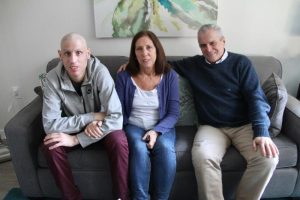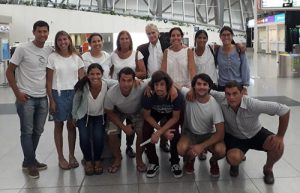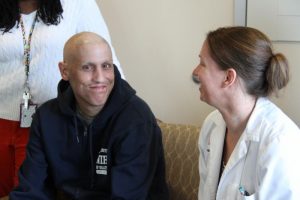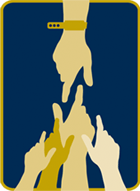At age 28, Santiago has become the first patient at the NIH to undergo a bone marrow transplant for a rare genetic condition, CTLA4. The disorder, which severely impairs a person’s normal regulation of the immune system, was discovered at the NIH’s National Institute of Allergy and Infectious Diseases (NIAID) just four years ago.

Santiago, his mother and father, Raquel and Jorge, from Montevideo, Uruguay
The disease was destroying Santiago’s liver and endangering his life when a family friend pointed him toward the NIH. Generous donors of Friends at NIH have made it possible for Santiago and his family to stay in an apartment near the Clinical Center while he is in treatment and for the 100 days of critical follow up.
Despite the rarity of Santiago’s disease, it runs in his Uruguayan family. Five of his 10 siblings have this rare condition and of those, two show severe symptoms, says Santiago’s father, Jorge, who carries the genes for the disease.

Santiago, center front, with his family — parents and 10 siblings
This offers the NIH the unique opportunity to treat not only Santiago but also to study his father and siblings, those with and without symptoms, to learn more about the disease. Two teams in two NIH Institutes are following Santiago and his family. Dr. Gulbu Uzel, who heads the family study team, says “it mean so much to be studying the whole family. We are trying to learn what protects the other ones who are not so sick. Then we can help others who are not symptomatic.”
Dr. Uzel believes the deficiency has been around for a long time. But its symptoms can vary widely, mimicking lymphoma or chronic respiratory diseases and pneumonia, making it hard to diagnose. The symptoms were so varied between Santiago’s siblings that it took a long time to link them to an inherited disease.
Santiago and his sister, Cecilia, 34, have the worst symptoms. Cecilia is not eligible for a bone marrow transplant because of liver damage. She receives intravenous infusions of immunoglobulin at NIH, which doesn’t cure the disease but improves her quality of life. Dr. Uzel sees three siblings and Santiago’s father. Like, Cecilia, the others receive immunoglobulin infusions.
Meanwhile, Santiago is in the home stretch of a 100-day post-transplant period. His parents, who have remained by his side throughout his treatment, are grateful for the support Friends at NIH donors have provided. “Words can’t describe our appreciation,” said Raquel. “It has given us the luxury of being away from the clinical setting and a quiet place to be together. Sometimes it is added stress being around so many other families in medical crisis.”

Santiago and his doctor, Jennifer Kanakry, National Cancer Institute, Clinical Head of Transplant
The head of Santiago’s transplant team, Dr. Jennifer Kanakry, says that despite significant concerns about his body’s ability to tolerate the transplant, “he has done exceptionally well. No transplant is without setbacks and complications,” she says, “but he has weathered his setbacks and continues to show signs that his new immune system is functioning well.”As Santiago nears the end of post-transplant monitoring, the likelihood of significant complications gets less and less, making us optimistic that he will benefit greatly,” Dr. Kanakry says.
If everything goes as planned, Cecilia will arrive in May for an infusion treatment. Then she, Santiago and their parents will head back to Uruguay, where Santiago hopes to return to work, and play soccer with his brother, a star of Uruguay’s national team.
About CTLA4 Deficiency
CTLA4 deficiency is caused by mutations in a gene called CTLA4, which gives cells instructions for making the CTLA4 protein. This protein functions as a brake to slow down and control the action of the immune system. Each person has two copies of the CTLA4 gene, one from each parent. The researchers determined that having a single working copy of CTLA4 is not sufficient to produce enough CTLA4 protein for a normal immune system.CTLA4 deficiency is one of more than 200 primary immune deficiency diseases that now can be diagnosed through advanced testing. What is learned by studying CTLA4 deficiency is valuable in broader cancer research.




